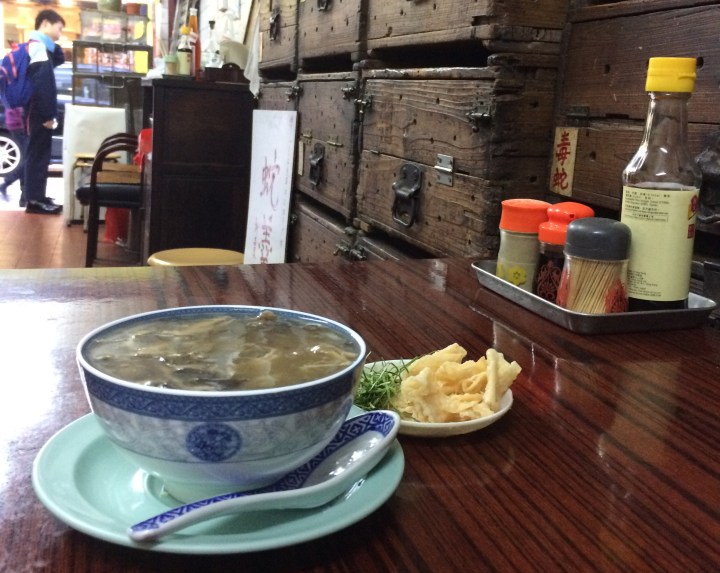THE ADVENTUROUS PALATE
There’s snake in my lemongrass

Hong Kong is a treat to taste buds serving up anything from poached salmon and mash to some of the best dim sum and bamboo noodles. If you happen to be there during the cool and rainy winter months, the only way to warm yourself like a local is with some slithery stuff. Carien du Plessis tried snake soup so that you don’t have to.
You might not be able to read the three Chinese characters in red on the Hong Kong shop-front saying: She Wong Lam (or in English: “Snake King Lam”), but you will know it’s what you’re looking for. The wire mesh cage with the shop’s cold-blooded speciality lurking inside it, staring out at passersby with angry, beady eyes, is a dead giveaway. Or, then, if it isn’t, the hand-painted sign on the cage with the only English translation in the shop underneath: “Poisonous”, will have you know you’re in the right place.
The rest of it is somewhat counter-instinctive: crossing the threshold into the shop with the snake watching you like you’re Eve’s evil twin, taking a seat at one of the small tables next to a stack of century-old wooden boxes with small breathing holes with Chinese-written labels on them, and then ordering from the friendly, reassuring waiter: “Snake soup?” He nodded that the HK$60 (roughly R120) was indeed the price for the only item on the menu. I must have looked uncomfortable next to the boxes, but the waiter assured me there were no snakes inside – or, at least, that’s what I understood.
In no time, he placed a bowl of almost see-through, gelatinous soup in front of me, accompanied by a small dish with dried lemongrass, and another with what he described in broken English as “Chinese chips” (fried wanton skins). The soup appeared wholesome even though the eel-like strips of meat looked like mini-snakes swimming in the broth.
The night before, as we were treated to seven-plus courses of more ordinary Chinese food at a large local establishment – thick sweet and sour handmade noodles, scallops and prawns, corn soup, steamed bk chi and other deliciousness – one of our hosts suggested the snake soup (which is only served at special restaurants). It’s a warming winter dish, and popular with locals. “Check on Google maps, there are many in the neighborhood,” he promised. He was reassuringly casual about it.
A quick search led me to She Wong Lam, two metro stops west from the Renaissance Hong Kong Barbour View Hotel, near the Wan Chi ferry terminal on Hong Kong Island where we stayed. It’s in Shebang Wan, a neighborhood that’s a mix of old and somewhat rundown establishments, and very hipster places – probably a sign that it’s slowly gentrifying.
Sure enough, the somewhat faded She Wong Lam itself was supposed to have closed down in July, according to the South China Morning Post, after almost 130 years in business. The shop’s manager, Mach Dairying, had decided to retire as he was almost 90 and there was nobody in the owner’s family with the appetite for taking over the place. It must have found a new owner, because my visit was just before Christmas, five or six months after it was supposed to have shut. There was no sign, however, of Master Mach.
The old man’s stamina is testament to the medicinal effectiveness of the soup. He started work there in 1948, aged 18, skinny and asthmatic – and scared of snakes. A daily dose of soup kept him going for 70 years straight.
Snake soup is a warming food in Chinese medicine, providing heat to the body. It alleviates respiratory, joint, and kidney problems, and, according to the waiter, the kind he served up for me on the day is also good for the skin. Perhaps I needed prolonged treatment to notice a difference.
The snakes at this establishment are sourced mostly in Malaysia and Indonesia, and the species range from Chinese rat snakes, Chinese cobras, to vipers. Cantonese people have been eating snakes for over 2000 years in China’s Guangzhou province, of which Hong Kong once was part.
The soup itself is surprisingly bland, although the texture of the snake – a white meat – is pleasantly chewy. If there was a hint of chicken in the taste, it must have been from the broth, as the soup is sometimes cooked up with chicken to make it more palatable. The waiter must have sensed I was looking for something to break the blandness, so he brought a bottle of wine and put a shot in the soup, and did the same for the two equally nervous first-time customers at the table opposite mine. “Snake wine,” he said with a smile. We smiled back politely.
It didn’t do much for the blandness – the lemongrass and “Chinese chips” were more helpful for that – but it made the soup more interesting. More research afterwards revealed that the liquor is, in fact, made with snake blood, but let’s not think about that. It could have been worse. Gordon Ramsey was served a beating snake heart in a shot of alcohol in Vietnam after the snake was killed in front of him.
Watch:
At least at She Wong Lam, the proprietor had the decency to wait until after the meal before pulling a snake out of – surprise surprise – one of the museum pieces next to which I was sitting. The eerie rely late lunch wriggled a few times in my tummy. Fortunately the live snakes are DE-fanged after they are caught, which means they can’t effect revenge on the diners and bite back. DM














 Become an Insider
Become an Insider